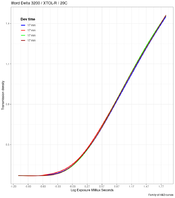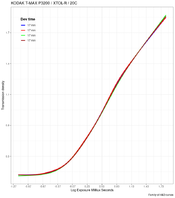aparat
Member
One of the most interesting emulsion technologies to emerge since the 1980s is the so-called "tabular grain" technology. Currently, these films are available for sale:
• Fujifilm Neopan 100 Acros II (Super Fine - ∑ Grain Technology)
• ILFORD DELTA 100 PROFESSIONAL (Core-Shell™ crystal technology)
• ILFORD DELTA 400 PROFESSIONAL (Core-Shell™ crystal technology)
• ILFORD DELTA 3200 PROFESSIONAL (Core-Shell™ crystal technology)
• KODAK PROFESSIONAL T-MAX 100 (KODAK T-GRAIN Emulsion)
• KODAK PROFESSIONAL T-MAX 400 (KODAK T-GRAIN Emulsion)
• KODAK PROFESSIONAL T-MAX P3200 (KODAK T-GRAIN Emulsion)
• FOMAPAN 200 Creative (T-crystals)
I have tested all of these emulsions. I developed the films in replenished XTOL (XTOL-R) at 20C, using rotary agitation, fixed in Kodafix, washed with Kodak's Hypo Clearing Agent, and processed the resulting data by a custom application. My goal is to present the data in chunks and, if possible, compare the modern emulsions to their conventional counterparts. The important thing to keep in mind is that the results are meant to offer an approximation of the film's performance under controlled conditions, only. It's quite possible, even likely, that the films would perform differently under different conditions and that my test results may not always align with your own pictorial or sensitometric experience. For the sake of brevity, I will be including analysis summaries, only. If you want the whole twelve-page test for each film, please let me know. I will be happy to make them available.
A lot has been written about tabular grain films over the years. For example, here's a quote from Popular Photography (Kolonia, 1992): "T-MAX 400 shows significantly denser highlights when overdeveloped by 30% than Delta or HP5 Plus.". He goes on to say, " As a concession to darkroom workers, Ilford formulated Delta to require less burning in when printing highlight detail than is often required with T-MAX 400." Another quote from the same article: "Ilford engineers state that Delta is less taxing on both film developer and fixer than Kodak's T-MAX." I am sure we can find lots of other information in old journals and forum posts. Therefore, it would be great if you all could share your more recent experiences with these films, and, in particular, tell us your preferences for different types of photography and different types of workflow.
• Fujifilm Neopan 100 Acros II (Super Fine - ∑ Grain Technology)
• ILFORD DELTA 100 PROFESSIONAL (Core-Shell™ crystal technology)
• ILFORD DELTA 400 PROFESSIONAL (Core-Shell™ crystal technology)
• ILFORD DELTA 3200 PROFESSIONAL (Core-Shell™ crystal technology)
• KODAK PROFESSIONAL T-MAX 100 (KODAK T-GRAIN Emulsion)
• KODAK PROFESSIONAL T-MAX 400 (KODAK T-GRAIN Emulsion)
• KODAK PROFESSIONAL T-MAX P3200 (KODAK T-GRAIN Emulsion)
• FOMAPAN 200 Creative (T-crystals)
I have tested all of these emulsions. I developed the films in replenished XTOL (XTOL-R) at 20C, using rotary agitation, fixed in Kodafix, washed with Kodak's Hypo Clearing Agent, and processed the resulting data by a custom application. My goal is to present the data in chunks and, if possible, compare the modern emulsions to their conventional counterparts. The important thing to keep in mind is that the results are meant to offer an approximation of the film's performance under controlled conditions, only. It's quite possible, even likely, that the films would perform differently under different conditions and that my test results may not always align with your own pictorial or sensitometric experience. For the sake of brevity, I will be including analysis summaries, only. If you want the whole twelve-page test for each film, please let me know. I will be happy to make them available.
A lot has been written about tabular grain films over the years. For example, here's a quote from Popular Photography (Kolonia, 1992): "T-MAX 400 shows significantly denser highlights when overdeveloped by 30% than Delta or HP5 Plus.". He goes on to say, " As a concession to darkroom workers, Ilford formulated Delta to require less burning in when printing highlight detail than is often required with T-MAX 400." Another quote from the same article: "Ilford engineers state that Delta is less taxing on both film developer and fixer than Kodak's T-MAX." I am sure we can find lots of other information in old journals and forum posts. Therefore, it would be great if you all could share your more recent experiences with these films, and, in particular, tell us your preferences for different types of photography and different types of workflow.

















